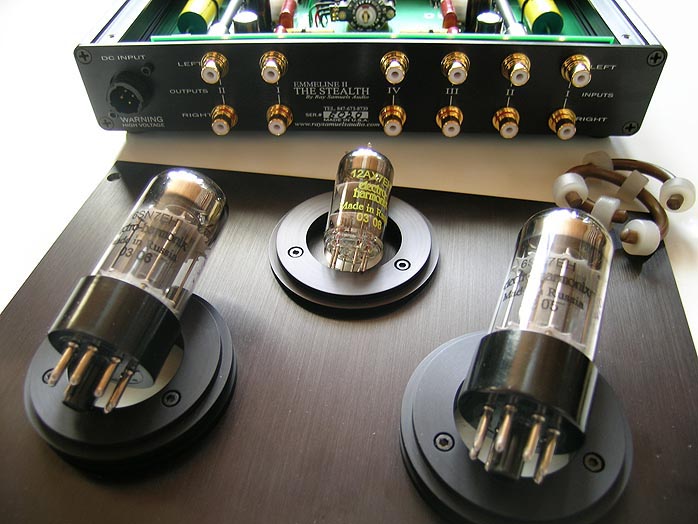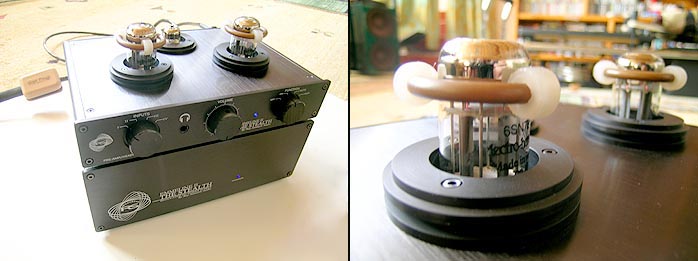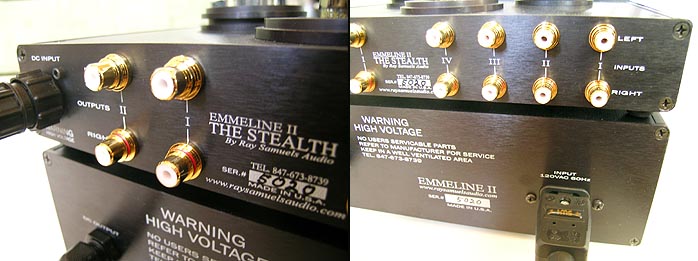 |
|
|
In my recent review of Mikhail Rotenberg's SinglePower MPX3 and while briefly comparing that amplifier to today's Stealth in headphone mode, I had called the latter having been audibly designed by a solid-state engineer. This was short-hand for saying that it belongs to the tonally neutral and invisible school. Talking with Ray Samuels on the phone afterwards, this turned out to not only be an accurate subjective assessment but a deliberate objective design choice. Ray's stated goal for the Stealth was to duplicate, via its outputs and precisely, the input of his Meridian 508.24 CD player. For that purpose, he's built a laboratory-grade A/B switcher that can instantaneously compare the input feed to the output signal.
You cannot fault a man for setting himself a goal and then attaining it, perfectly. As an end user, you can only disagree with the goal per se if it happens to diverge from your own. In this case and when used as headphone amp, the Stealth will only sound as good as your source. Despite using tubes, it won't telegraph bloom, harmonic density and the heightened thermionic soundstage layering and sculpting unless you preceded it with a CD player like Einstein's Last Record Player or the Audio Aero Capitole MkII or the MiniMax unit, all of which employ tube-driven output stages.
When used as a preamp -- the primary raison d'être for the Stealth according to Ray -- you can introduce whatever tubular influences you fancy via your chosen amplifier. If that was your aim, you could pursue it without risking the counter-active or excessively additive results that strapping multiple tube-driven devices in series could otherwise incur. If the Stealth is a paragon of neutrality, placing it into any component chain won't affect the usual additive/subtractive interactions one wit. 0 + 0 = 0.
|
|
 |
|
|
Before we get to the listening impressions, let's play a brief charade of Demons & Angels, with their interchangeable positions stand-ins for the usual polarization of opinions and arguments that heat up certain chatroom strings. For this review, let's turn Ray's ideal of absolute neutrality into the angelic argument and any proponents of audible tube virtues into the demonic counterpart.
- Angel: Any preamplifier whose output signal isn't identical to its input signal is guilty of distortion and thus unfit to be called a high fidelity device.
- Demon: You boring goodie two-shoe. Any preamplifier that uses tubes but doesn't employ their specific sonic signatures might as well be solid-state. If the preamplifier doesn't enhance the signal in the dynamic and timbral domains, use a cheap passive unit and be done with it. Don't waste perfectly good tubes on nothing.
- Angel: You guys from the Underworld simply advocate endless tube rolling and voicing jitters because you don't know what exact sound to stand for in the first place. Your upgrade options are nothing but an underhanded ploy to sell overpriced designer parts and to disguise that your basic models don't cut the mustard.
- Demon:: Fixing a design without offering any user adjustments is tantamount to imposing the designer's voice on the customer. We advocate designs that are completely transparent to the tubes so a customer gets the exact tube attributes he or she wants without being strapped into the designer's straight jacket.
- Angel: Lizard shit. You're simply advocating being all things to all people while overlooking that a preamplifier's primary task is to uncover and then pass on as many details as are on the recording. That's the truth and nothing else and thus not up for discussion.
- Demon: Not, you winged sacrilege. A preamp's duty is to optimize the interface between source and amplifier. Have you ever tried to plug a gain-adjustable source straight into an amplifier only to have dynamics and harmonic density squashed for an anemic and bleached-out sound?
Ad infinitum. It's easy to see how anything winged can be made to grow fangs and vice versa. Spin doctors in politics do it all the time. As you may have surmised by now, this writer takes his place with the demons in this argument. Now, let me qualify this. Prior to encountering the Wyetech Labs Pearl preamplifier, I was an angel. Using tube amplifiers on my Duo hornspeakers, all I wanted from a preamplifier was maximum resolution and advanced remote control features - or, as I once put it, "table water without carbonation to not dilute the bouquet of the following wine". The tubed Pearl introduced me to resolution and superior noise floors apparently every bit the equal of my reference solid-state unit. Then it did something very demonic - it added microdynamic scale and soundstaging plasticity to a very potent degree, giving me two big steps forward without asking for even a pimple of my soul in return.
|
|
|
 |
|
Having thus turned into a carvorter-with-demons, today's review component puts me somewhat at odds with both its stated design objective and with fulfilling it to a 't'. Used as a preamp, I want the enhanced dynamics and 3-dimensionality which the Stealth doesn't provide on principle. I don't want the voluptuous harmonic thickening tubes can also do since I've already got full control over that aspect with the TimbreLock of my monoblocks and the preceding Zanden tube DAC. So here the Emmeline's reluctance to default on neutral is very much in accord with my needs - while we're talking speakers and preamp use, that is.
|
|
 |
|
|
As a headphone user without the benefit of my TimbreLock, I want my headphone amp to also add that third ingredient of harmonic bloom. Obviously, I cannot applaud the Stealth for failing to do that in my speaker system and then fault it for the same behavior in the headphone system. This little excursion illustrates how what you have and what you hope to accomplish determines what the component nestling into this scenario has to contribute to be considered the perfect fit. If the $2,495 Stealth was exclusively a headphone amplifier, it'd be considered pretty steeply priced for all but the most hardcore headphone groupies. But since it's primarily a preamplifier with added -- and optimized -- headphone functionality, you'd have to call it very good value if it held its own against other $2,500-or-more preamplifiers that don't accommodate headphones at all.
|
|
 |
|
|
As delivered, the Stealth was outfitted with an Electro-Harmonix 12AX7 and two Electro-Harmonix 6SN7s. Ray doesn't believe in making optimum performance contingent on dealing with the escalating prices and limited supplies of NOS valves. Instead, he has adapted his circuit to these affordable production tubes which anyone ordering a Stealth is supplied with. While he doesn't claim that $200 Sylvanias wouldn't bump things up another notch or two, it's not something he openly advocates or pushes. Ditto for stock-everything-else. The Stealth is one-size-fits-all, with no upgrade or tweak options available other than adjusting the gain structure by replacing the 12AX7 driver with lower-gain 12AT or 12AU variants. That's a nice feature to optimize the useable range of the stepped attenuator with amplifier power ratings and speaker or headphone efficiencies. To experiment with gain shifting, Ray had included a black-plate 12 AU7; and to get a taste for sonic rolling, one 12AX7 Telefunken. With all of these preliminaries covered, let's get funky like a proper Raylette and have some fun in the big rig.
|
|
|
 |
|
 |
|
|
 |
|
|
|
 |
|
 |
|
|
|
|
|
|
|
|
|